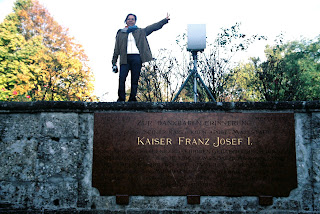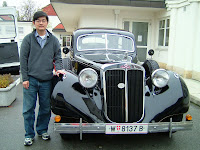
Austria, one of the riches country in the world, is a mountainous land lock country in central Europe surrounded by Alps. It borders Germany and Czech Republic to the north, Slovenia and Italy to the south, Slovakia and Hungary to the east and Switzerland and Liechtenstein to the west. About 9 million of population in an area of about 33 sq.meter are using German as an official language and having a high standard of living. The historical multi-cultural character of Austria had been greatly influenced by various ethnic groups including German, Hungarian, Jews, Czechs and Slovaks. It was the birth place of many world famous composers including Johann Strauss and Mozart and has long been an important center of music innovation. Austria was addressed as an European capital of classical music.
Vienna (Wien) is the capital and primary city in the country and was designated a UNESCO world heritage site. Originally a Celtic settlement and became a Roman Empire in around 500 BC. Vienna has been a cultural center for arts and science, music and fine cuisine since 1440 when it was then the capital of Holy Roman Empire. Though a capital of a small and neutral country, Vienna plays a major role in European and world politics due to its importance for the east and west dialogue and also its status in international relationships. Since 1979, it has been in 3rd seat of UN office.
Salzburg is the 4th largest city in Austria is Salzburg and it is one of the best preserved city centers in Northern Alps. The Old Town with world famous Baroque architecture was listed in UNESCO world heritage site since 1996. The city located 300km west of Vienna and just 150km away from Munich of Germany. It was the birth place of 18th century composer Wolfgang Amadeus Mozart (27/01/1756 - 1791). In memory of this great musician, 35 churches in the city started ringing the bell after 8 pm at his 250th anniversary and there were ceremonies throughout the year.



Getreidegrasse was also known as Grain Lane, though the name was nothing related to grain. The narrow street has became famous with many gilt and wrought-iron signs identifying the guilds of craftsmen who once lived here and offered their products and services. It is one of the oldest street in Salzburg and a busy shopping street in Old Town. The house at No.9 Getreidegrass was the place where Mozart was born and lived till age of 17. It was said that since 1987, there was a puppet woman selling puppet in a brown basket along the street every day. We did not have a chance to meet her.



Variety of fresh vegetables, fruits, flowers, cheese, smoked meats and all kinds of European bread were offering by dealers at the open market at Universitatsplatz and there was also a souvenir store at the center of the area. The colorful fresh products and flower stalls has become an attraction to all tourists.



The Residence Fountain at Residenzplatz, the largest square in Old Town, was created by an Italian sculptor in 1656-61. With 4 water sprouting horses surrounded a large rock on which stand 3 giants supporting a large dish on their shoulder. The 15m high fountain is said to be the largest and most beautiful Baroque fountain outside Italy. It lies between the former prince-archbishops and the Residenz-Neugebaude.



The protesting students gathered at Residenz-Neugebaude (New Residence), which is at the east side of Residenzplatz that housed part of the Carolino Augusteum Museum. The pink building was St. Michael's Church, the oldest parish church in the city, which was probably built in 788 and had it altered in Baroque appearance in 18th century.



The horse carriages, the man-chess, The Saint Michael's Church and Residence Fountain at Old Town Square harmoniously share the same glory at Old Town Square. The open market was once inside the lane of Gologasse during the time of rebuilding.



The house of Mozart at Mozart Square is now owned by Mozarteum Foundation and houses exhibition of pictures, documents of his family and musical instruments belonged to him.



(1) The pink building is a gathering center for gay and lesbian (2) Abundant fruits and food offering from open stalls at Mozart Square. (3) A gorgeous little cozy restaurant on the way to Hohensalzburg fortress.



The Majestic Cathedral is the most significant Italian monumental structure north of Alps. It began in 1614 and was the 3rd cathedral at the same place. The 1st cathedral was built in 767-774 and replaced in 12th century with a roman basilica which was destroyed by fire in 1598.


The 3-aisle St. Peter's Abbey Church was built in 1130-1143 when the old one was burnt down. It was made into a Baroque style in 17th to 18th century with an onion shaped tower on top.



The Hohensalzburg fortress, symbol of the city, is the largest and best preserved citadel in Europe. It was constructed in 1077 and continuously expanded and fortified in following centuries. In the middle of St Peter's Cemetery is the Gothic St Margaret Chapel. It was built in 1491 with old memorial slabs onto the outer wall. Catacombs where early Christian prayer sites are hew into the cliff could be seen over the archways which was built in 1626.


Saint Peter's Cemetery where origins could be found in about 700 BC was the most important tourist attraction in Salzburg.


The funicular railway to one of the bastions of the Fortress is to replace the 10 minutes walking time. The tombs at St Peter's Cemetery are neatly taken care off with shrubs and flowers beautifully grown at all corners and the Single Chapel Church looks unique and extraordinary.




The people buried at this beautiful yard of Saint Peter's Cemetery included Maria Anna, Mozart's sister.


Preserved ancient wall of Salzburg and the beautiful view of old town city from the other side of the river.



The king of waltz, Johann Strauss (25/10/1825 - 03/06/1899) born in Vienna, was world famous composer of light music. He composed over 500 pieces of waltzes, operettas and ballet kind of dance music and The Blue Danube was one of them. The bronze status of this great musician with violin was erected at the city park right in front of The Spa Salon, which was opened in 1867 and has been a place for the light-hearten muse of the waltz and operetta.


The building of Musical Concert hall is entirely different in day and at night when performance was on . The beautiful ceiling when adorned with light at night looks real gorgeous.



The main entrance of Mirabell Palace in Salzburg.


Mirabell Palace, located outside the inner Old Town of Salzburg, was the most visited place in the city. It was built with Italian and French models of baroque style in 1606. All Statues were dating from 17th to 18th century.



The Sculptures in the niches are the finest products in Europe baroque.



Panoramic view of Mirabell Palace.


The central hall has turned into the best wedding hall in the world now.





Salzburg's Old Town with world famous baroque architecture is one of the best preserved city centers in Northern Alps and nominated as a world heritage site since 1996.



Mirabell Gardens originally had only a castle built by Archbishop Wolf Dietrich in 1606 for his mistress Salome Alt but later expanded and turned into a summer residence of the archbishops and today it attracts the visitors with its colorful world of flowers and sculptures.



Garden was opened to public by Emperor Franz Joseph in the year 1854.


The gardens are a horticultural master piece and became a popular backdrop for photographers.





The place where the steps are, were one of the famous landmark featured in the musical film "The Sound Of Music". The steps were used as a musical scale when Maria and the children were dancing around the horse fountain singing "Do-Re-Mi"





A scenic view of this mountainous city.


Vindona is the roman name of Vienna, which means "good wine in the region". Vienna is the only large city in the world who owns its vineyard and with a significant production of wine. There are about 50k hectares of land used for vineyards in Austria and 32k wine farmers producing 2.5 million hectoliters of wine every year.



Wine testing at open vineyard.


Cheers with unknown friends !


The word "Winzer" means wine farmers. The grapes from the yard are transfer to the concealed factory to process and fermented into wine.



There are hundreds species of grapes produced in this farm. The company make wine as well as liquor chocolate. A huge bundle of chocolate grapes displayed at the entrance door never failed to attract the visitors' s attention.



Fermented wine was packed and concealed in wooden drums before bottling.



The under ground wine cellar.



Vintage wine has to be stored in this cellar for years to gather its age.



Drink until you drop in this wine testing session as there were hundreds of various type of wine produced in this vineyard.


The tempting cuisine at the town center and a lake resort restaurant offer fantastic view of its serene environment at the rural site.




The high jet fountain was built in 1873 as 1st high spring water conduit in Vienna and redesigned into an illuminated fountain in 1906. The landmark of Vienna was the 137 m high steeple of Saint Stephen's Cathedral. With its foundation stone laid in the year 1359, it was a prominent example of the Gothic architecture.



Display of the interesting ancient vehicles inside the hall and at the compound of Wienna Hotel where we stayed.


